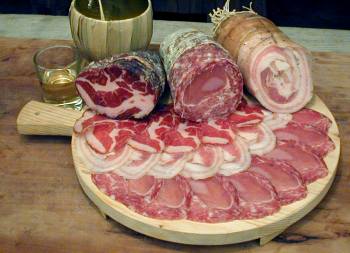Salumi … not to be confused with Salami

Lately many Bay Area foodies have added a new work to their vocabulary: Salumi.
In the old days, most restaurants would just call it an antipasto plate (including cured meats, mozzarella, and tomatoes). Salumi is merely a term that refers more specificially to the Italian cured meats that are served with an antipasto plate. Salami is just one of many types of salumi.
Here in the Bay Area, it seems everyone is offering salumi plates these days. Susan and I are fond of the salumi at several restaurants including: Berkeley’s Eccolo, and Oakland’s Oliveto, Cesar (ok, they’re also in Berkeley), and my favorite Dopo (linking to Yelp review until they get a website).
Some think hand made salumi products are a lost art that people will be happy to rediscover. Paul Bertolli, formerly of Oliveto, left the restaurant to start his own salumi business, Fra’mani. Although much of Fra’mani’s wares are sold in Bay Area markets and restaurants, he’s shipping more of it out of state each month.
There are so many kinds of salumi, it’s hard to know what to order. Sampler platters are great but who’s gonna remember what those little items you like best were next time?
Here’s a list of some varieties that I like:
Ciccioli: prepared by pressing and aging what is left of the pork after most of the other preparations have been carried to effect.
Pancetta: also referred to as Italian bacon. It’s taken from the pork belly but it’s both cured and dried unlike bacon. (thanks to Patrick for pointing out my typo on bacon vs pancetta)
Speck: The German type is mostly lard (they call it Lardo in Italian), the Italian type is made from hog legs and is cured.
Coppa, Capocollo and Soppressa: like salami, the meat is encased. Unlike salami the meat is not ground up with fat added. Using mostly neck portions of the hog, it’s often combined with wine, salt, and spices.